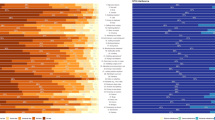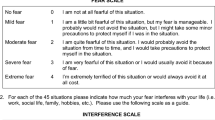Summary
This article is the presentation of the main phobia data from the Epidemiologic Catchment Area (ECA) program, with a sample size ofn=18,571. Work on this article was initiated in 1981 at the beginning of the ECA study, but publication has been delayed a decade. Phobias are determined from information from the Diagnostic Interview Schedule (DIS), classified according to DSM III. Phobias are found to be the most common psychiatric disorder in the community, more common than major depression or alcohol abuse or dependence in the month prior to interview. The one month prevalence is between 4.0 and 11.1%, with the estimated prevalence in the United States being 6.2%. There were nine community surveys of the prevalence of phobia that pre-dated the ECA studies, which found a wide range of prevalence rates from 1.2% to 26.1%. By far the strongest risk factor associated with phobias is the presence of another psychiatric disorder. Prevalence rates of simple phobia and agoraphobia are found in the ECA studies to be significantly higher in women; social phobia, which is less prevalent, has no significant sex difference. The prevalence rates are higher in younger age groups, and in those with low socioeconomic status (SES). The onset of phobias occurs primarily in the childhood or teenage years, and they tend to be chronic conditions. Less than a quarter of phobics receive treatment.
Similar content being viewed by others
References
Marks IM (1969) Fears and phobias. Academic Press, New York
Mavissakalian M, Barlow DH (eds) (1981) Phobia: psychological and pharmacological treatment. Guilford Press, New York, pp 1–33
DuPont RL (ed) (1982) Phobia: a comprehensive summary of modern treatments. Brunner/Mazel, New York
Chambless DL, Goldstein AJ (ed) (1982) Agoraphobia, multiple perspectives on theory and treatment, Wiley, New York
Sheehan DB (1982) Current concepts in psychiatry: panic attacks and phobias. N Engl J Med 307: 156–158
Klein DF (1982) Medication in the treatment of panic attacks and phobic states. Psychopharmacol Bull 18: 85–90
Marks IM, Gray S, Cohen D, Hill R, Mawson D, Ramm E, Stern RS (1983) Imipramine and brief therapist-aided exposure in agoraphobics having self-exposure homework. Arch Gen Psychiatry 40: 153–162
Marks I (1983) Are there anticompulsive or antiphobic drugs? Review of the evidence. Br J Psychiatry 43: 338–347
Mavissakalian M, Michelson L, Dealy RS (1983) Pharmacological treatment of agoraphobia: imipramine versus imipramine with programmed practice. Br J Psychiatry 143: 348–355
Zitrin CM, Klein DF, Woerner MG (1978) Behavior therapy, supportive psychotherapy, imipramine, and phobias. Arch Gen Psychiatry 35: 307–316
Sheehan DV, Ballenger J, Jacobsen G (1980) Treatment of endogenous anxiety with phobic, hysterical, and hypochondriacal symptoms. Arch Gen Psychiatry 37: 51–59
Sheehan DV, Sheehan KH (1982) The classification of anxiety and hysterical states: part 1, historical review and empirical delineation. J Clin Psychopharmacol 2: 235–244
Sheehan DV, Sheehan KH (1982) The classification of anxiety and hysterical states: part 2, toward a more heuristic classification. J Clin Psychopharmacol 2: 386–393
Zitrin CM, Klein DF, Woerner MG, Ross DC (1983) Treatment of phobias: 1. comparison of imipramine hydrochloride and placebo. Arch Gen Psychiatry 40: 125–138
Klein DF, Zitrin CM, Woerner MG, Ross DC (1983) Treatment of phobias: 2. Behavior therapy and supportive psychotherapy: are there any specific ingredients? Arch Gen Psychiatry 40: 139–145
Langner TS, Michael ST (1963) Life stress and mental health. Free Press of Glencoe, London, p. 407, Table 15-2
Agras S, Sylvester D, Oliveau D (1969) The epidemiology of common fears and phobia. Compr Psychiatry 10: 151–156
Warheit GJ, Schwab JJ, Holzer III CE, Nadean SE (1973) New data from the south on race, sex age & mental illness. Presented at the annual meeting of the American Sociological Association, Aug. 28–30, New York, NY
Warheit GJ (Personal written communication April 1984)
Williams BL (1976) The epidemiology of common fears and diffuse phobias: sociodemographic analysis. Dissertation Abstract International: Section A, 36: 5565-A (Order No. 76-4284)
Weissman MM, Myers JK, Harding PS (1978) Psychiatric disorders in a US urban population: 1975–76. Am J Psychiatry 135: 459–462
Costello CG (1982) Fears and phobias in women: a community study. J Abnorm Psychol 91: 280–286
Uhlenhuth EH, Balter MB, Mellinger GD, Cisin IH, Clinthorne J (1983) Symptom checklist syndromes in the general population. Arch Gen Psychiatry 40: 1167–1173
Myers JK, Weissman MM, Tischler GL, Holzer III CE, Leaf PJ, Orvaschel H, Anthony JC, Boyd JH, Burke JD, Kramer M, Stolzman R (1984) Six-month prevalence of psychiatric disorders in three communities: 1980–82. Arch Gen Psychiatry 41: 959–967
Binder J, Dobler-Mikola A, Angst J (1981) An epidemiological study of minor psychiatric disturbances: a field study among 20-year-old females and males in Zurich. Soc Psychiatry 16: 31–41
Regier DA, Boyd JH, Burke JD Jr, Rae DS, Myers JK, Kramer M, Robins LN, George LK, Karno M, Locke BZ (1988) Onemonth prevalence of mental disorders in the United States. Arch Gen Psychiatry 45: 977–986
Regier DA, Myers JK, Kramer M, Robins LN, Blazer DG, Hough RL, Eaton WE, Locke BZ (1984) The NIMH Epidemiologic Catchment Area Program: historical context, major objectives, and study population characteristics. Arch Gen Psychiatry 41: 934–941
Eaton WW, Holzer CE, Vonkorff M, Anthony JC, Helzer JF, George L, Burnam MA, Boyd JH, Kessler LG, Locke BZ (1984) The design of the ECA surveys: the control and measurement of error. Arch Gen Psychiatry 41: 942–948
Bourdon KH, Boyd JH, Rae DS, Burns BJ, Thompson JW, Locke BZ (1988) Gender differences in phobias-results of the ECA community survey. J Anxiety Disord 2: 227–241
Thompson JW, Burns BJ, Bartko J, Boyd JH, Taube CA, Bourdon KH (1988) The use of ambulatory services by persons with and without phobia. Med Care 26: 183–198
Sartorius N (1980) Epidemiology of anxiety. Pharmakopsychiatr Neuropsychopharmacol 13: 249–253
Weissman MM, Myers JH, Thompson WD (1981) Depression and its treatment in a US urban community-1975–1976. Arch Gen Psychiatry 38: 417–421
Shapiro S, Skinner EA, Kessler LG, VonKorff M, German PS, Tischler GL, Leaf PJ, Benham L, Cottler L, Regier DA (1984) Utilization of health and mental health services, three epidemiologic catchment area sites. Arch Gen Psychiatry 41: 971–978
Marks IM, Herst ER (1970) A survey of 1,200 agoraphobics in Britain: features associated with treatment and ability to work. Soc Psychiatry 5: 16–24
Diagnostic and Statistical Manual, 3rd edn (1980) American Psychiatric Association, Washington D. C., pp 225–232
Robins LN, Helzer JE, Croughan J, Williams JBW, Spitzer RL (1981) NIMH Diagnostic Interview Schedule, Version III. University School of Medicine, St. Louis
Robins LN, Helzer JE, Croughan J, Ratcliff KS (1981) National Institute of Mental Health Diagnostic Interview Schedule, its history, characteristics, and validity. Arch Gen Psychiatry 38: 381–389
Boyd JH, Robins LN, Holzer CE, VonKorff M, Jordan KB, Escobar JI (1985) Making diagnoses from DIS data. In: EAton WW, Kessler LG (eds) Epidemiologic field methods in psychiatry; the NIMH Epidemiologic Catchment Area Program. Academic Press, New York
Robins LN, Helzer JE, Ratcliff KS, Seyfriend W (1982) Validity of the Diagnostic Interview Schedule, Version II: DSM III diagnoses. Psychol Med 12: 855–870
Hesselbrock V, Stabenau J, Hesselbrock M, Mirkin P, Meyer R (1982) A comparison of two interview schedules: the Schedule for Affective Disorders and Schizophrenia-Lifetime and the National Institute of Mental Health Diagnostic Interview Schedule. Arch Gen Psychiatry 39: 674–677
Wittchen HU, Semler G, VonZerssen D (1985) A comparison of two diagnostic methods: clinical ICD diagnoses vs. DSM III and Research Diagnostic Criteria using the Diagnostic Interview Schedule (Version 2). Arch Gen Psychiatry 42: 677–684
Burnam MA, Karno M, Hough RL, Escobar JI, Forsythe AB (1983) The Spanish Diagnostic Interview Schedule: reliability and comparison with clinical diagnoses. Arch Gen Psychiatry 40: 1189–1196
Anthony JC, Folstein M, Romanoski AJ, VonKorff MR, Nestadt GN, Chahal R, Merchant A, Brown CH, Shapiro S, Kramer M, Gruenberg EM (1985) Comparison of the lay Diagnostic Interview Schedule and a standardized psychiatric diagnosis: experience in Eastern Baltimore. Arch Gen Psychiatry 42: 667–675
Shah BV (1981) SESUDAAN: Standard Errors Program for Computing of Standardized Rates from Sample Survey Data. Research Triangle Institute, Research Triangle, NC
Shah BV, Folsom RE, Harrell FE, Dillard CN (1984) Survey Data Analysis Software for Logistic Regression. Research Triangle Institute, Research Triangle, NC
SAS Institute, Inc. (1986) SUGI Supplemental Library User's Guide, 5th edn. SAS Institute, Cary, NC, pp 269–293
Shah BV (1988) RTILOGIT. Research Triangle Institute, Research Triangle, NC
Nam CB, Powers MG (1965) Variations in socioeconomic structure by race, residence, and life cycle. Am Soc Rev 30: 97–103
Nam CB, Powers MG (1968) Changes in the relative status of workers in the United States, 1950–1960, Soc Forces 48: 158–177
Powers MG, Holmberg JJ (1978) Occupational status scores: changes introduced by the inclusion of women. Demography 15: 183–204
Christie KA, Burke JD Jr, Regier DA, Rae DS, Boyd JH, Locke BZ (1988) Epidemiologic evidence for early onset of mental disorders and higher risk of drug abuse in young adults. Am J Psychiatry 145: 971–975
Angst J, Dobler-Mikola A, Scheidegger P (1982) A panel study of anxiety states, panic attacks, and phobia among young adults. Paper read at the Research Conference on Anxiety Disorders, Panic Attacks, and Phobia, Key Biscayne, Fla., December 9
Regier DA, Hirschfeld RMA, Goodwin FK, Burke JD Jr, Lazar JB, Judd LL (1988) the NIMH Depression Awareness, Recognition, and Treatment Program — structure, aims, and scientific basis. Am J Psychiatry 145: 1351–1357
Sheehan DV, Sheehan KE, Minichiello WE (1981) Age of onset of phobic disorders: a reevaluation. Compr Psychiatry 22: 544–553
Mendel JGC, Klein DF (1969) Anxiety attacks with subsequent agoraphobia. Compr Psychiatry 10: 190–195
Marks IM, Herst ER (1970) A survey of 1,200 agoraphobics in Britain—features associated with treatment and ability to work. Soc Psychiatry 5: 16–24
Marks IM, Gelder MG (1966) Different ages of onset in varieties of phobias. Am J Psychiatry 123: 218–221
Burns LE, Thorpe GL (1977) Fears and phobias: epidemiological aspects and the national survey of agoraphobics J Int Med Res 5: (Suppl) 132–139
Murphy GE (1982) The clinical management of hysteria. JAMA 247: 2559–2564
Smith GR, Jr, Monson RA, Ray DC (1986) Psychiatric consultation in somatization disorder—a randomized controlled study. N Engl J Med 314: 1407–1413
Barsky AJ, Klerman GL (1983) Overview—Hypochondriasis, bodily complaints and somatic styles. Am J Psychiatry 140: 273–283
Author information
Authors and Affiliations
Rights and permissions
About this article
Cite this article
Boyd, J.H., Rae, D.S., Thompson, J.W. et al. Phobia: prevalence and risk factors. Soc Psychiatry Psychiatr Epidemiol 25, 314–323 (1990). https://doi.org/10.1007/BF00782887
Accepted:
Issue Date:
DOI: https://doi.org/10.1007/BF00782887




